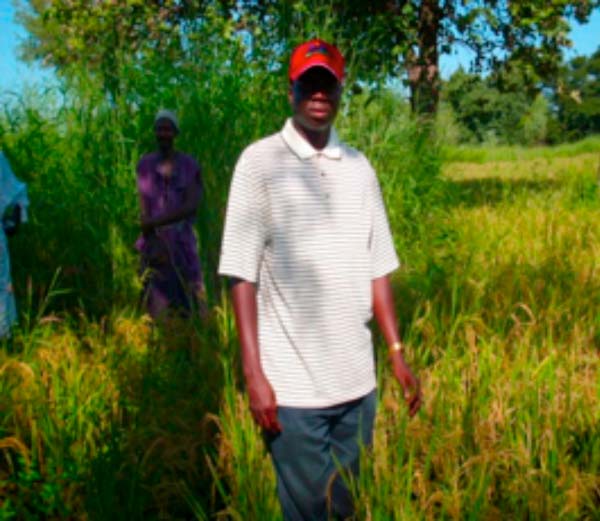
The
agricultural sector of the Gambia remains and will continue to remain as the
engine of economic growth that can create more job opportunities for the youths
and the women folk of rural communities. The agricultural system of the Gambia
needs new paradigm shift from rain fed agriculture or subsistence farming to
economic vibrant agriculture which calls for massive capital investment.
According to empirical research it has become increasingly clear that
“investing in agriculture is the best way to end hunger, malnutrition, and
extreme poverty in Africa and Gambia is not exceptional” earns a living from
the land, agriculture can create economic growth spread more evenly across
society, and extending deeper into rural areas, and helping more women, who
make up 40 % of labour force. Furthermore, agricultural transformation and
development in the Gambia will help to revitalize the rural areas, turning them
from zones of economic stagnation today, to communities of economic prosperity.
This will require significant investments in boosting agricultural
productivity, development of rural infrastructure, provision of affordable
finance, as well as incentives for the private sector to establish food
processing and agro-allied industries in rural areas.
Primarily
transformation of agricultural sector is the issue of research and development.
Developed and developing nations entirely depends on research programmes for
the generation of agricultural technologies focusing on crop agronomy,
livestock improvement and breeding programmes, aquaculture, handling and
management of post-harvest losses to serve as a stimuli for economic growth.
The application of bio-technology in modern research and development is
yielding many achievements and progressing in the area of multiplication and
resistance of crops and livestock to adverse environmental condition.
Importantly, government needs to rejuvenate our National Agricultural Research
Institute (NARI) and International trypano-tolerance (ITC) by allocating enough
funds that would really propel their research base activities. Revamping the
infrastructure with modern research tools, standard laboratories, green houses,
storage facilities and gene banks for the preservation of our local and modern
traits would also go a long way in maintaining and sustaining our local
collections. The use of indigenous local knowledge system must not be forgotten
and has to be incorporated in modern system research. For example countries
like India are making the best use of local knowledge system in agricultural
research development. Modern research in tandem with use of local knowledge
will improve our local base research capabilities.
The
extension system and delivery mechanism of proven agricultural technologies to
the end users’ has to be redesigned in a participatory manner using the
innovation platforms. The innovation plat form is technology development and
transfer tool where all the actors have key role in the process of technology
generation and transfer. The interaction and positive correlation amongst the
actors along the value chain would increase production and productivity of both
crops and livestock of smallholder farmers. The agricultural sector must not
forget the training and demonstration centres both for crops and livestock that
may require thorough rehabilitation in terms of infrastructure and installation
of modern facilities with enough supply of human labour at the centres that
would facilitate the transformation process of agriculture. Remarkably, transformation of
agricultural development in the area of horticulture and livestock sub-sectors
as the main driving force of reducing poverty, increasing income and attainment
of food security. The government needs to pay more attention to vegetable
production that earns more money than crop farming according to empirical
research. This is possible by creating and establishing more vegetable gardens
in regions where vegetable production and marketing is more pronounced and
basing on needs of the community.
Use of modern irrigation facilities,
standard water reticulation system and proper fencing as in the case of
FAO-MDG1c vegetable gardens serves as appropriate technologies ideal for the
women farmers. On the other hand, production of food crops alone cannot achieve
food and nutritional security but through the integration of livestock such as
cattle, sheep, goat and poultry production, processing and marketing along the
value chain approach would help a lot in addressing marketing problems. Food
security cannot be achieved without judicious use of chemical fertilizer
particularly for cereal crops looking at fragile nature of our soil health
conditions. Therefore, the government needs to create that enabling environment
where small holder farmers can have easy access to and afford fertilizer at
reasonable price meaning the issue of subsidy has to come into play to increase
production and productivity.
Importantly,
the agribusiness sector would need business oriented approach, simply
re-orienting away from treating agriculture as a ‘way of life’ or social
welfare system to a business entity and to frame a transformation agenda that
is public-sector and private partnership. The agricultural sector should focus
on market oriented approach basing on consumers desire and needs. The establishment
of market outlets linking producers and buyers at local level, national,
regional and international with strong coordination from downstream to upstream
would help smallholders’ farmers to produce both in quantity and quality for
high premium price. This has to be followed by strong production development,
marketing strategy and market diversification for consumer satisfaction.
The
Gambia Livestock Marketing Agency (GLMA) mandated by an act to coordinate the
buying and selling of livestock and it products should be given maximum support
in term of financial, capital and human resources to spare head strategic
objectives. The revitalization of well-known household name of the ‘livestock
show’ at Basse, Yoro Beri Kunda and Abuko has to re-surface again as an
economic activity in enhancing livestock production and marketing while
reducing the importation of live animals from other neighbouring countries. It
will further serve as a spring board to market competition by creating more
market opportunities to smallholder farmers. This can only be possible when
Department of Livestock Services, Gambia Livestock Marketing Agency (GLMA) and
National Livestock Owners Association (NLOA) strongly collaborate with the
support of agricultural projects particularly the components that touches on
livestock promotion and marketing.
Agricultural financing is one key area of
possible intervention by the current government. The government in consultation
with donor partners or genuine business entrepreneurs needs to establish
Agricultural banks or cooperative banks. The establishment of agro-banks or
farmers’ cooperative banks would be a right footing for smallholder farmers to
have easy access to soft loan with minimal interest rates and collaterals. This
kind of intervention will serve as attraction for the young agro-entrepreneurs
to embrace agriculture as business entity and confidence among producers will
be attained. The issue of matching grants as enshrined in most of agricultural
projects can be linked to the agricultural banks so that small-holder famers
can have easy access to the available funds with minimal interest avoiding long
standing of bureaucracy.
Essentially,
Central Project Coordinating Unit (CPCU) under the ministry of agriculture
needs to be revisited for better coordination and coherent management of
project funds and activities. On the other side of the coin, the central
project coordinating unit can be merged to the planning service unit under the
management structure of the Director. The planning service unit as it is the
most appropriate unit that can handle all the agricultural data on livestock,
crops, and market information systems otherwise it can be re-named as
Agriculture Bureau of Statistics (ABS). In that situation, all the agricultural
projects would be under the purview of the unit for better planning, budgeting,
implementing and controlling of available resources as in the case of other
government ministries.
The
public sector has a critical role to play in enabling these conditions and letting
businesses flourish. In successful cases of agricultural transformation,
liberalization of input markets, innovative financing, infrastructure
development (irrigation, storage, and rural roads), and land availability,
accessibility, ownership are important as were technologies and outreach plans
are implemented. Today, new agricultural technologies, especially the
application of information and communication technologies to agriculture,
financial services and information services, open up new ways to replicate
these successes, as well as drive new ways of modernizing value chains, and in
a particularly inclusive manner.
Importantly,
working policy documents such as the Agriculture and Natural Resource Policy
(ANRP) carefully needs to be reviewed involving all the necessary stakeholders
to become one working tool for all the ANR line ministries and departments. In
conclusion, we need to make crop and livestock production friendly for people
of all ages and both genders by using appropriate technology that suits our
local conditions. We need to bring the youth back to cultivation by creating
that enabling environment of incentives and motivation. We must ensure that as
we increase productivity using the modern forms of technology in crop and
livestock production would be mindful of safe guarding our environment.



